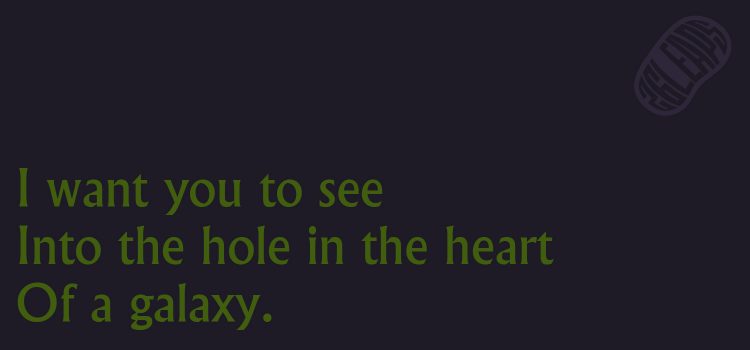
Jill Hopper
Peering into a black hole
Eight lidless eyes stare into space,
Seeking rays that have taken millions of years to reach Earth,
Filtering their way through clouds of plasma, dust and gas.
In his lab, an astrophysicist catches the data as it rains down,
Strains it through a net of formulae, trying to understand.
His name means ‘moonlight’; he’s loved space since he was a kid,
Glued to Star Trek, puzzling over mysteries.
Now he’s part of a web: two hundred people, their gaze directed upwards,
To the hole in the heart of a distant galaxy.
They are scattered across seven continents, they speak many languages
But one language: Science. They ask one question: What is beyond the beyond?
The image swims, tightens, sharpens.
A dark
O
With a
Mane of fire.
The first black hole to be seen by human eyes.
It has a name, M87. A dead star, billions of times the mass of our own sun,
It may be as old as the universe. Paradoxical phenomenon.
The more it swallows, the bigger it gets.
Light swirls around it like water down a plughole;
Time slows down; gravity grows so strong it rips everything apart.
The very fabric of existence ceases to be.
And yet, there’s one at the centre of every galaxy, spewing out energy,
Supporting stars and solar systems and all the potential life they contain.
With this blink, Einstein’s notions are unravelling – spooling and looping.
More and more scientists are being drawn into the effort, and
Those lidless eyes are still staring out, forward into time and back into time.
Research story
People around the world were awestruck when, in April 2019, the first image of a black hole was published. The image, of a vast entity known as M87, was the fruit of a years-long international collaboration called the Event Horizon Telescope project, involving astronomers, astrophysicists, engineers and computer scientists.
I was on holiday in Northumberland at the time, where at night the skies were dark and full of stars. As I scrolled through the media coverage on my mobile, I had no idea that in four months’ time I would be sitting in a basement at UCL, interviewing the astrophysicist Dr Ziri Younsi, one of the minds behind this particular ‘great leap’.
I felt a bit intimidated as I prepared for our meeting. I imagined Dr Younsi as rather like Sheldon Cooper, the pompous theoretical physicist in the TV series The Big Bang Theory. But in fact he couldn’t have been more different: young, modest and bounding with energy. Best of all, he was incredibly eloquent, conveying the mind-blowing implications of what he and the team had discovered, without once resorting to jargon.
Ziri’s father is Algerian and his mother English, and he grew up in London with what he describes as “the best of both cultures – discipline and creativity.” He speaks three languages: French, German and Tamazight – a North African dialect. When he told me the name Ziri means ‘moonlight’ in Tamazight, I gasped.
I can’t imagine a better name for an astrophysicist.
